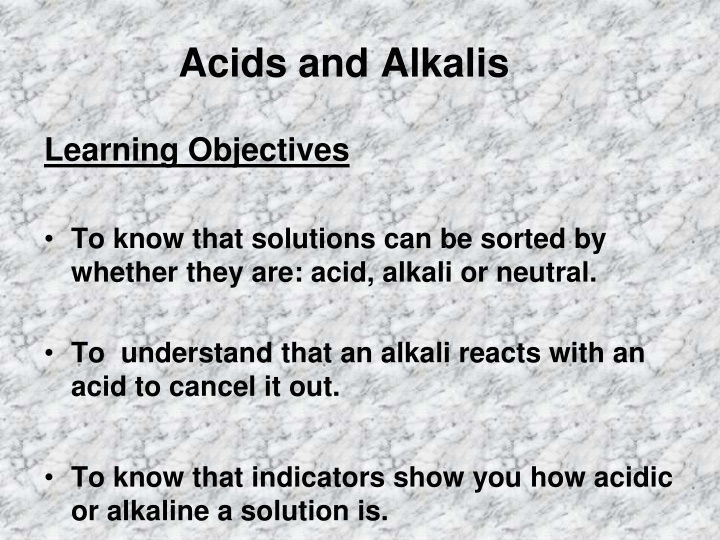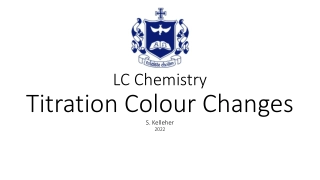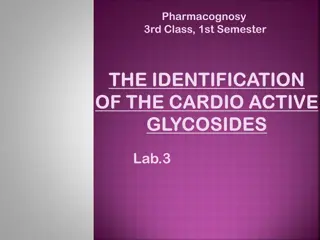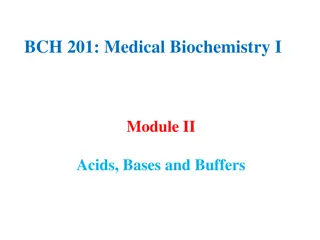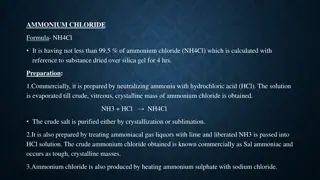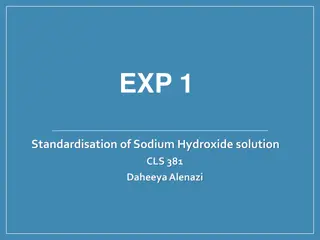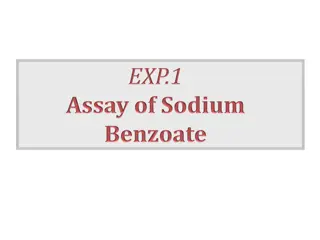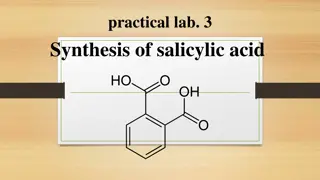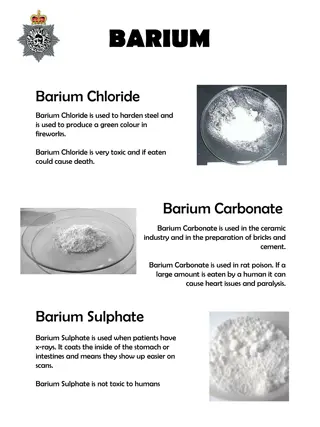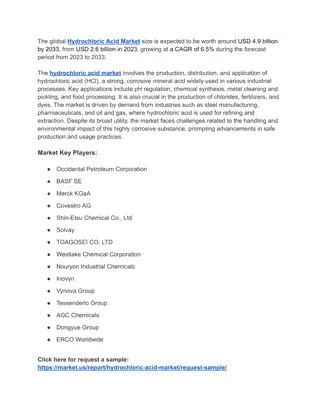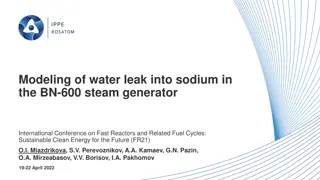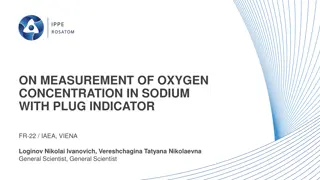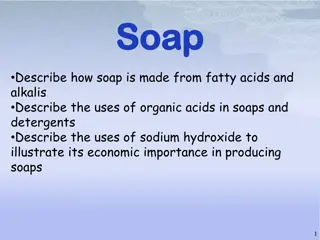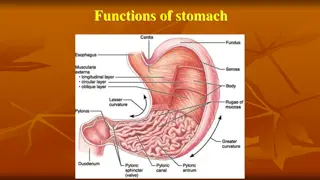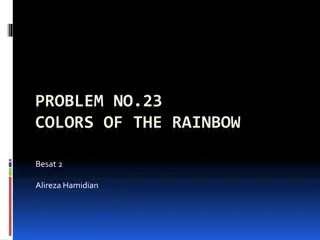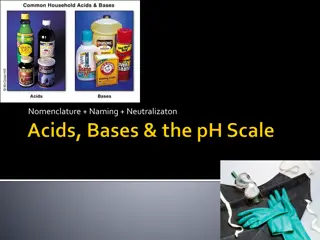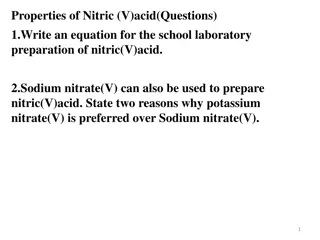Standardization of 0.1N Sodium Hydroxide Using Hydrochloric Acid
This experiment involves preparing and standardizing approximately 0.1N sodium hydroxide (NaOH) using standardized hydrochloric acid (HCl). The process includes removing carbonate from sodium hydroxide, preparing solutions, and conducting reactions. Various methods like Ba(OH)2 method and anion exchange method are utilized for carbonate removal. Detailed steps for preparation, reaction, and calculations are provided for achieving the desired NaOH solution.
Download Presentation

Please find below an Image/Link to download the presentation.
The content on the website is provided AS IS for your information and personal use only. It may not be sold, licensed, or shared on other websites without obtaining consent from the author.If you encounter any issues during the download, it is possible that the publisher has removed the file from their server.
You are allowed to download the files provided on this website for personal or commercial use, subject to the condition that they are used lawfully. All files are the property of their respective owners.
The content on the website is provided AS IS for your information and personal use only. It may not be sold, licensed, or shared on other websites without obtaining consent from the author.
E N D
Presentation Transcript
Acids and Alkalis Learning Objectives To know that solutions can be sorted by whether they are: acid, alkali or neutral. To understand that an alkali reacts with an acid to cancel it out. To know that indicators show you how acidic or alkaline a solution is.
Acids and alkalis When a substance dissolves in water it makes a solution. Solutions can be sorted by whether they are: acid, alkali or neutral.
When the oxide of some non-metals dissolve in water they make an acid. Acids have a sour taste. They are corrosive.
Acids react with metals and carbonates. Metal + Acid Salt + Hydrogen magnesium + hydrochloric acid hydrogen magnesium chloride + Acid + Carbonate Salt + Water + Carbon dioxide sulphuric acid + copper sulphate + water + copper carbonate carbon dioxide
Acids There are many acids present in our everyday lives. Lemon juice contains citric acid, and vinegar contains ethanoic acid. Some strong acids are hydrochloric acid, sulphuric acid and nitric acid. Some weak acids are ethanoic acid, citric acid and carbonic acid.
Common Acids in the laboratory Hydrochloric acid sulfuric acid Nitric acid Nitric acid Ethanoic acid Phosphoric acid HCl H2SO4 HNO3 CH3COOH H3PO4 Study the chemical formula of all the acids, which element is common in all the acids? hydrogen
Acids in water Complete the following to show the dissociation of the following acids. H2SO4 (aq) 2H+ (aq) + SO42- (aq) CH3COOH (aq)H+ (aq) + CH3COO- (aq)
Basicity of acids The basicity of an acid is the no. of hydrogen ions produced when one molecule of the acid ionises/dissociates in water. Acid HCl H2SO4 HNO3 H3PO4 CH3COOH H2CO3 Basicity monobasic dibasic monobasic tribasic monobasic dibasic HCl
Bases and Alkalis, Pg 5 Bases mostly metal oxides or hydroxide Formula of oxide : Formula of hydroxide: O2- OH- Question: Give an exception of a base which is not metal oxide or hydroxide Aq NH3
Bases and Alkalis Alkalis Alkalis =Soluble bases Examples of alkalis: all group 1 hydroxide such as NaOH, KOH calcium hydroxide (limewater), Ca(OH)2 aqueous ammonia (NH3.H2O) aqueous barium hydroxide, Ba(OH)2
Bases and Alkalis Alkalis When alkalis dissolve in water, hydroxide ions, OH- are produecd. Why is aqueous ammonia (Formula NH3.H2O) an alkali? Ammonia dissociates in water to give hydroxide ions and ammonium ions. NH3 + H2O NH4 The alkaline properties of aqueous ammonia is due to + + OH- hydroxide ions.
Bases and Alkalis Chemical Reactions 1. Bases react with acid to form salt and water, a process called neutralisation. 2. Alkalis give precipitates with solutions of most metal salts. 2NaOH (aq) + CuSO4 (aq) Cu(OH)2 + Na2SO4 (s) (aq) Blue ppt
Bases and Alkalis Chemical Reactions 3. When warmed, bases react with ammonium salts to give salt, water and ammonia. Ammonium salt + base salt + water+ ammonia NaOH + NH4Cl NaCl + H2O + NH3 Observation Colourless and pungent gas liberated. The sodium hydroxide solution remains colourless.
The pH scale pH - measure of the concentration of H+ in solution. - between 0 and 14 Acidic lower pH -> higher conc. of H+ Alkaline higher pH -> higher conc. of OH-
Indicators - Substances that have different colours in acidic and alkaline solutions. - most are regarded as weak acids
Indicators E.g. Methyl Orange in acidic medium - red in allkaline medium - yellow pH at which it changes colour - pH 4 colour at this pH - orange
Litmus Test Litmus is an indicator. It changes colour in acid and alkaline solutions. Litmus is red in an acid. Litmus is blue in an alkali.
Neutralisation Acids and alkalis react with each other. The alkali cancels out the acid in the reaction. This is called neutralisation. A salt is made.
Salts The salt made depends on the acid and alkali used. The salt contains the metal atom from the alkali, and part of the acid molecule. The salts of sulphuric acid are known as sulphates. The salts of hydrochloric acid are known as chlorides. The salts of nitric acid are known as nitrates.
Universal Indicator Universal indicator changes colour in acids and alkalis. Neutral ACIDS ALKALIS Its colour shows the strength of an acid or alkali.
The pH scale 1 6 Acids 8 - 14 Alkalis 7Neutral
Applications of Neutralisation Insect Stings Bee stings are acidic and can be neutralised with baking soda (bicarbonate of soda). Wasp stings are alkaline and can be neutralised with vinegar. Indigestion: Our stomach carries around hydrochloric acid. Too much of this leads to indigestion. To cure indigestion, you can neutralise the excess acid with baking soda or specialised indigestion tablets.
Factory Waste: Liquid waste from factories is often acidic. If it reaches a river it will destroy and kill sea life of many forms. Neutralising the waste with slaked lime can prevent this. soils. Soil Treatment: When soils are too acidic (often as a result of acid rain) they can be treated with slaked lime, chalk or quicklime, all alkalis. Plants and crops grow best in neutral More Applications of Neutralisation?
